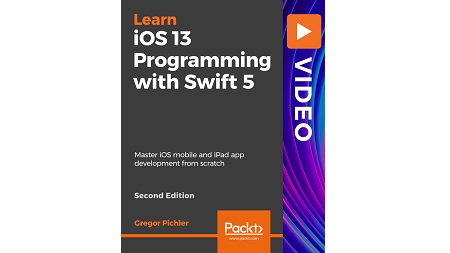
English | MP4 | AVC 1920×1080 | AAC 48KHz 2ch | 4h 49m | 1.03 GB
Unleash the power of Swift 5 in your applications
The iOS 13 SDK arrives as a major milestone in the evolution of the Swift language with new and interesting features for developers such as Dark Mode, Apple Sign-in, CloudKit, SwiftUI, UIKit, and more. If you’re looking to get started with iOS 13 programming, unravel the potential of Swift 5, and publish your apps on the iPhone and iPad, then this is the right course for you.
This course will be a perfect guide on your iOS journey; it will take you through the capabilities of iOS 13 and show you how to put its principles into action. It equips you to handle the most common tasks an iOS developer will deal with daily. We begin by creating a burger-recipe application and gradually add features to it as we move on. You will also learn how to build simple apps without code using SwiftUI and master iPadOS, which is specifically created for tablets. You will learn about the differences between UIKit and SwiftUI, and explore how SwiftUI handles the look-and-feel of different platforms such as iOS, iPadOS, and MacOS.
By the end of the course, you will have built an appetizing burger-recipe app and published it to the App Store.
Learn
- Everything you need to get started with iOS development
- How to use Swift 5
- Build your first application from scratch and release it on the App Store
- Handle most common iOS tasks effortlessly
- Get a sneak peek into SwiftUI and bring iOS applications to the Mac
- Create and monetize iOS applications that customers will love
Table of Contents
Getting Started with Xcode 11 and Swift 5
1 The Course Overview
2 Installing and Setting Up Xcode 11
3 Variables versus Constants
4 Explicit versus Inferred Types
5 Optionals versus Non-Optionals
Developing a Tabbed App
6 Setting Up Our Project
7 Introduction to Interface Builder
8 Designing the User Interface
9 Exploring Actions and Outlets
Displaying Data in a UITableView
10 Understanding UITableView and When to Use
11 Building Our Model and Populating Data from JSON
12 Working with Delegate and Data Source
13 Troubleshooting and Common Mistakes
Navigating Between View Controllers
14 Adding More View Controllers to Our Project
15 Creating Segues Between View Controllers
16 Passing Data from One View Controller to Another
Optimizing UI for Other Devices
17 Building an Adaptive UI with Auto Layout
18 Using Auto Layout in a Custom Cell
19 Optimizing Our App for an iPad
20 Bring Our iPad App to macOS
21 Supporting Dark Mode and Dynamic Type
Persisting Data with Core Data
22 Introduction to Core Data
23 Adding Core Data to the Existing Project
24 Building Our Core Data Model
25 Updating Our Project to Work with Core Data Objects
26 Displaying Data in NSFetchedResultsController
27 Syncing Core Data with CloudKit
28 Preparing Our App for Asynchronous Loading
Making the App Ready for the World
29 Signing in with Apple
30 Making the App Ready for the App Store
31 How to Monetize an App
32 How to Avoid Being Rejected by Apple
Experience the Power of SwiftUI
33 Introduction to SwiftUI
34 Replicating Basic Interface of Our App in SwiftUI
Resolve the captcha to access the links!